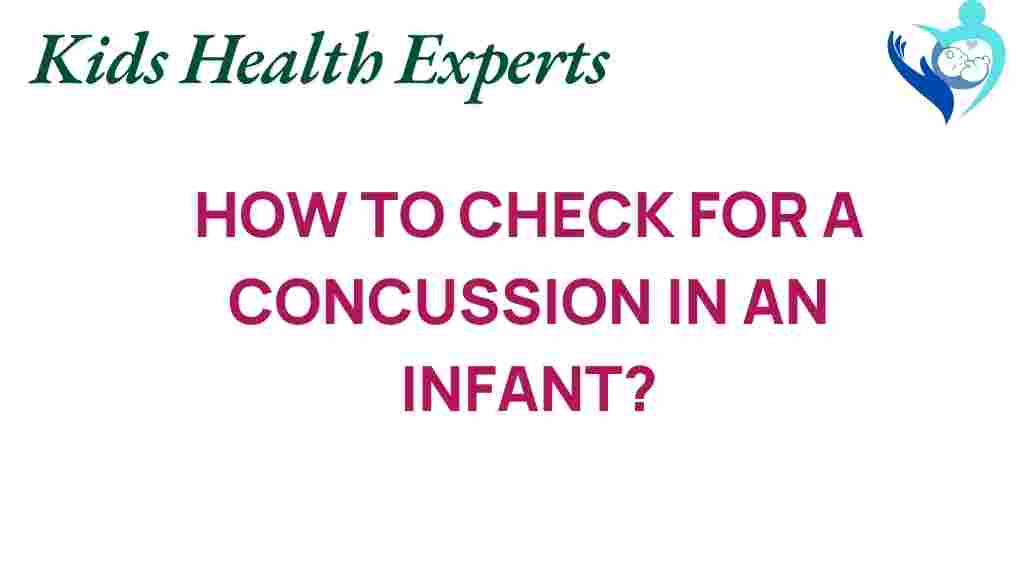Unraveling the Mystery: How to Check for a Concussion in an Infant
As parents, ensuring the health and safety of our little ones is of paramount importance. One of the more concerning issues in pediatric health is the risk of a concussion, especially in infants who are still developing their physical coordination and cognitive abilities. Understanding how to identify the symptoms of a concussion, diagnose it appropriately, and ensure the best care for your infant is crucial. This article delves into the signs of brain injury, the process of diagnosis, and parental guidance for early detection of this potentially serious condition.
What is a Concussion?
A concussion is a type of brain injury that is caused by a bump, blow, or jolt to the head. In infants, this might occur from falls, accidents during play, or even during childbirth. The brain is a delicate organ, and any trauma can lead to serious implications for an infant’s health.
Symptoms of Concussion in Infants
Detecting a concussion in an infant can be challenging due to their inability to communicate clearly. However, being aware of the following symptoms can assist in early detection:
- Unusual Crying: A change in the pitch or intensity of an infant’s cry can be a red flag.
- Increased Irritability: If your baby is unusually fussy or difficult to soothe, this could indicate discomfort.
- Changes in Sleep Patterns: Excessive sleepiness or difficulty waking up can be signs of a concussion.
- Loss of Balance: Observe if your infant seems unsteady or has trouble with coordination.
- Feeding Difficulties: A noticeable decrease in appetite or refusal to eat may be a concern.
- Vomiting: Repeated vomiting after a head injury can be a serious symptom.
- Seizures: Any seizure activity warrants immediate medical attention.
Step-by-Step Process to Check for a Concussion
If you suspect your infant may have a concussion, follow these steps to assess their condition:
Step 1: Assess the Situation
Determine how the injury occurred. Understanding the context (e.g., fall, bump) can help in evaluation.
Step 2: Observe Symptoms
Watch for the symptoms mentioned earlier. Take note of any that arise within hours or days after the injury.
Step 3: Check Responsiveness
Gently wake your infant if they are sleeping. Assess their alertness and responsiveness. If they do not wake easily or seem unusually lethargic, seek medical help.
Step 4: Monitor for Changes
Keep a close eye on your infant’s behavior over the next 24 to 48 hours. Note any worsening symptoms or new developments.
Step 5: Consult a Pediatrician
If you notice any concerning symptoms, it is essential to contact your pediatrician immediately. They may advise you to bring your infant in for a thorough evaluation.
Diagnosis of Concussion in Infants
Once you visit your pediatrician, a proper diagnosis will involve:
- Physical Examination: The doctor will perform a physical exam, checking for any visible signs of injury.
- Cognitive Assessment: They may assess your infant’s responsiveness and cognitive function.
- Imaging Tests: In some cases, your pediatrician may recommend imaging tests like CT scans or MRIs to rule out serious brain injuries.
Safety Tips for Infant Care
Preventing concussions starts with ensuring a safe environment for your infant. Here are some tips to enhance safety:
- Use Safety Gear: Always use appropriate safety gear when your infant is in strollers, car seats, or playpens.
- Supervise Play: Ensure that your infant is supervised during playtime, especially in environments where falls could occur.
- Keep Hazardous Items Away: Remove sharp objects and other potential hazards from your infant’s reach.
- Secure Furniture: Anchor heavy furniture to the wall to prevent tipping.
Parental Guidance for Early Detection
As a parent, being vigilant about your infant’s health is crucial. Here’s how to stay ahead:
- Educate Yourself: Familiarize yourself with the signs and symptoms of concussions.
- Maintain Open Communication: Discuss any concerns with your pediatrician and ask questions about infant care and safety.
- Document Incidents: Keep a record of any incidents where your infant may have hit their head, along with any symptoms observed afterward.
Troubleshooting Tips
If you are in a situation where you are unsure if your infant has a concussion, consider these troubleshooting tips:
- Trust Your Instincts: If something feels off, don’t hesitate to seek medical advice.
- Watch for Changes: Continuous monitoring of your infant’s behavior is vital. Changes can occur hours or days after the incident.
- Seek Immediate Help for Severe Symptoms: If your infant exhibits severe symptoms such as persistent vomiting, seizures, or loss of consciousness, seek emergency medical help right away.
Conclusion
In conclusion, understanding how to check for a concussion in an infant is essential for ensuring their health and safety. Parents play a critical role in early detection and intervention when it comes to brain injuries in young children. By being aware of the symptoms, following a step-by-step assessment process, and knowing when to seek medical attention, you can help protect your infant from the potential consequences of a concussion.
For more information on pediatric health and safety, consider visiting the American Academy of Pediatrics. Remember, your vigilance and care are your infant’s best defense against injury.
For further reading on how to maintain a safe environment for your infant, check out our article on infant safety tips.
This article is in the category Care and created by KidsHealthExperts Team
